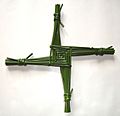Imbolc facts for kids
Quick facts for kids Imbolc |
|
|---|---|
| Also called | Lá Fhéile Bríde (Irish) Là Fhèill Brìghde (Scottish Gaelic) Laa'l Breeshey (Manx Gaelic) |
| Observed by | Historically: Gaels Today: Irish people, Scottish people, Manx people, Celtic neopagans and Wiccans |
| Type | Cultural, Pagan (Celtic polytheism, Celtic Neopaganism, Wicca) |
| Significance | beginning of spring |
| Celebrations | feasting, making Brigid's crosses and Brídeógs, visiting holy wells, divination, spring cleaning |
| Date | 1 February (or 1 August for Neopagans in the S. Hemisphere) |
| Related to | Gŵyl Fair y Canhwyllau, Candlemas, Groundhog Day |
Imbolc is a festival belonging to Brigid, the Celtic goddess who, in later times, became famous as a Christian saint. At first, her festival on February 1 was known as "Imbolc" or "Oimelc", two Gaelic names which refer to the lactation of the ewes. Lactation is the flow of milk that happens when the baby lambs are born in the spring, and Gaelic languages are those spoken in countries like Ireland and Scotland.
Imbolc was, and still is, a time to celebrate that winter would soon be over. Sometimes in Ireland, the first flowers are coming up at the time of this festival, even when there is still snow on the ground.
Later, the Roman Catholic Church replaced this festival with Candlemas Day on February 2, a day that now belongs to the Virgin Mary. On this day, people may have ceremonies or processions by candlelight - walking together in the dark, with the only light coming from candles they carry. The may also sing songs to Brigid, or say poems or prayers to her.
In both Pagan and Christian celebrations, Brigid is celebrated as a powerful female figure, who brings light, inspiration, and healing to the world.
Images for kids
See also
 In Spanish: Imbolc para niños
In Spanish: Imbolc para niños






